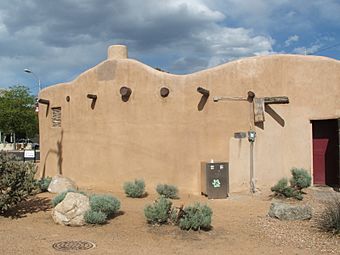Estufa facts for kids
|
Estufa
|
|
 |
|
| Location | Southeast corner of University Boulevard and Dr. Martin Luther King Boulevard, Albuquerque, NM |
|---|---|
| Built | 1908 |
| Architect | Charles Lembke (Tri-Alpha member): University President William G. Tight: members of the Alpha Alpha Alpha Fraternity |
| Architectural style | Pueblo Revival |
| MPS | New Mexico Campus Buildings Built 1906–1937 TR |
| NRHP reference No. | 88001542 |
Quick facts for kids Significant dates |
|
| Added to NRHP | September 22, 1988 |
The Estufa is a special old building on the University of New Mexico campus in Albuquerque, New Mexico. It was built between 1907 and 1908 by a group of students called a fraternity. Since 1915, it has been the main meeting place for the university's Pi Kappa Alpha chapter. The building is famous for its unique history, and it's said that no woman has ever been inside. The Estufa is listed on both the New Mexico State Register of Cultural Properties and the National Register of Historic Places.
The Estufa looks like a kiva, which is a traditional meeting place used by the Pueblo people. It has very thick walls made of adobe (a type of mud brick). Inside, there is one room with no windows and seats around the edges. The university president at the time, William G. Tight, helped guide the building's construction. He wanted to use the Pueblo Revival architecture style on campus. The Estufa was one of the first buildings in New Mexico to use this unique design.
What Does "Estufa" Mean?
The word "estufa" comes from Spanish and means "a stove" or "a warm room." In the past, this word was also used to describe a special assembly room, like a kiva, used by the Pueblo Native Americans. So, the building's name connects it to these traditional Pueblo structures.
History of the Estufa
The Estufa was built from 1907 to 1908 by a student group called Alpha Alpha Alpha. This group was also known as the Yum Yum Society. The university president, William G. Tight, really supported the project. He wanted to make the Greek system (student fraternities and sororities) stronger at the university.
President Tight was also a big fan of Pueblo Revival architecture. He had already built two new dorms and a boiler plant in this style. Because of his influence, the Alpha Alpha Alpha fraternity decided to build their meeting room like a kiva, which they called an "estufa." This design was a traditional part of Pueblo architecture.
Work on the Estufa started in January 1907. It took a while to finish, but it was ready by April 1908. The student newspaper, U.N.M. Weekly, wrote about it that month. They said it was "the most unique fraternity house in the world." They also mentioned it looked like the "San Domingo estufas" (referring to kivas at Santo Domingo Pueblo).
The newspaper described the building as one large, oval-shaped room with no windows. To get in, you used to climb an outside staircase to the roof. Then, you would go through a trap-door and down steps into the room. Inside, there was a large fireplace and wooden beams, all designed in an Indian style. The whole building was covered with cement, making it look like a real estufa.
The Alpha Alpha Alpha group held their first meeting in the Estufa on February 20, 1908, even though it wasn't fully finished yet. In 1915, Alpha Alpha Alpha became the Beta Delta chapter of Pi Kappa Alpha. This was the first national fraternity chapter at the university. The Estufa has been their main meeting spot for almost 100 years.
Over its long history, the Estufa has been part of many student pranks. It has been broken into or vandalized many times, often by students from a rival fraternity, Sigma Chi. Only members of Pi Kappa Alpha are supposed to go inside. According to their tradition, no woman has ever seen the interior of the building.
The Estufa has survived many challenges. It has been hit by cars both by accident and on purpose. It has also faced attempts to damage it with fire and other things. For example, in 1947 alone, the building was set on fire four times. In 1958, a gas explosion accidentally damaged it, injuring five people. In the 1960s, it looked like the building might be torn down for a road project. However, city planners changed the road's path, saving the Estufa. In 1988, it was added to the New Mexico State Register of Cultural Properties and the National Register of Historic Places.
Building Style
The Estufa is a one-story, oval-shaped building. It was designed to look like a kiva from Santo Domingo Pueblo. This makes it one of the first examples of the Pueblo Revival architecture style in New Mexico. It is also the oldest building in this style still standing at the University of New Mexico.
The walls of the Estufa are made of adobe and are about 14 inches (36 cm) thick. Originally, you entered the building by climbing an outside staircase to the roof and then going through a trapdoor. Now, it has a regular door. Inside, there is one room with no windows. It's about 500 square feet (46 square meters) in size. People have described the inside as a pit with seating around the edges.
Even though many buildings at the University of New Mexico are in the Pueblo style, the Estufa is one of only two buildings on campus actually made from adobe. The other adobe building is the Naval Science Building, designed by John Gaw Meem.
See also
 In Spanish: Estufa (Albuquerque) para niños
In Spanish: Estufa (Albuquerque) para niños



